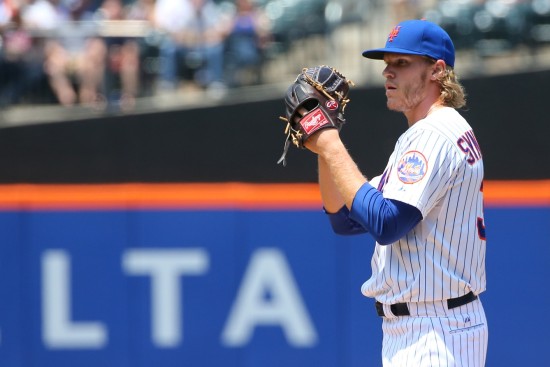
Stat Line: 7.1 IP, 0 R, 6 K’s, 0 BB
Living Low
Noah Syndergaard continues to show great command of his fastball and curveball, throwing nearly all of his pitches below the hitter’s belt. In yesterday afternoons start, Syndergaard threw only seven of his 101 pitches above the belt with one of those pitches coming intentionally during Ryan Howard’s first inning at-bat in an attempt to induce a strikeout swinging. The other six were hanging curveballs, three of which came in the same at-bat against Chase Utley in the third inning. None of the pitches left up in the strike zone led to a hit.
There are three main advantages to keeping the baseball down in the strike zone:
- It allows the pitcher to get away with throwing pitches over the plate rather than sitting or living on the corners of the plate. In yesterday’s outing, Syndergaard threw many pitches that were left over plate but only gave up six hits all of which were singles. This was due to the fact that it is much harder to lift or elevate pitches located down in the strike zone. This creates less extra base hits and home runs thus forcing an offense to “manufacture” their runs (score runs by singles, walks, steals, and sacrificing at-bats to move runners ahead).
- It allows the pitcher to get away with pitches that are thrown up in the strike zone. As seen in Utley’s third inning at-bat, Syndergaard hung three curveballs resulting in zero aggressive swings and an eventual pop-up to the third baseman. As a result of Syndergaard throwing most of his pitches down in the strike zone, Utley was expecting or “looking” for pitches to be thrown down in the strike zone. When the curveballs hung up in the strike zone, it caught Utley off guard resulting in defensive swings or no swings on pitches that Utley traditionally drives into the outfield or over the fence.
- The baseball is further away from the batters eye compared to a pitch at the belt-high level or above, making it more difficult to judge the height of low pitch which results in a batter having more difficulty recognizing if a pitch is in the strike zone. Since the pitch is further away from the batters eye it also makes it more difficult for the hitter to make solid contact.
Throwing Strikes
As noted earlier, Syndergaard threw 66 of his 101 pitches for strikes (65%). Although Syndergaard did an average job with first pitch strikes (16 of 27 approximately 60%), he didn’t reach a three ball count until the sixth inning and only had a three ball count in three different at-bats resulting in zero walks.
Concern with Changeup
Keith Hernandez touched upon the subject during the SNY broadcast as the development of Syndergaard’s changeup is one looming concern. Syndergaard threw four changeups yesterday, three were thrown out of the strike zone and one was fouled off. The major concern with his changeup isn’t so much the lack of command as it is the lack of sharp movement and his delivery of the pitch. As Hernandez noted in the broadcast, Syndergaard telegraphs his changeup to the batters by slowing down his pitching motion when he delivers his changeup allowing the hitters to pickup his changeup as he releases the baseball. Although he didn’t give up any hits off of the changeup, that could easily change against better lineups and hitters.
Syndergaard doesn’t need to develop an above average changeup since his fastball and curveball are well above average but he needs to have the ability to show his changeup to hitters with either command or sharper movement on the changeup. If Syndergaard is able to progress his changeup in one of those two areas it will give him the ability to put another pitch into the minds of the opposing hitters which will lead to even more swing and misses.















